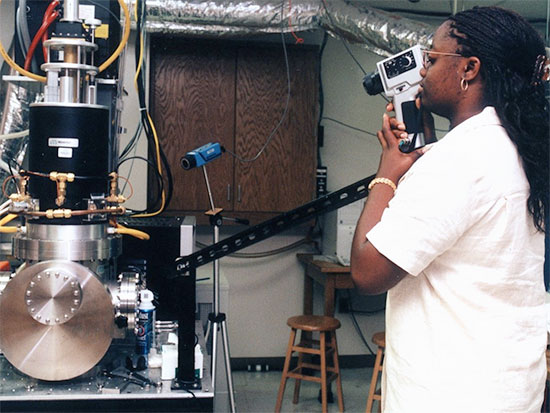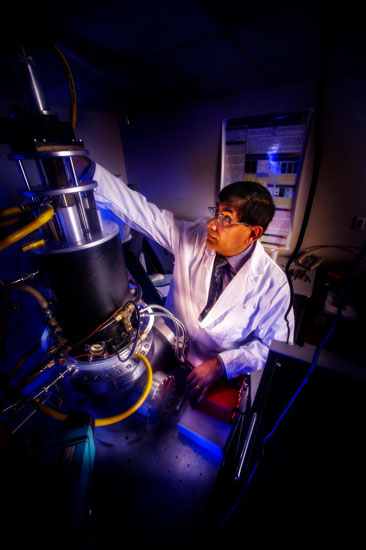Need more information? Contact us
 Microwave plasma system for materials synthesis.A five-year, $20 million award from the National Science Foundation will help universities across Alabama, including the University of Alabama at Birmingham, collaborate to better understand interactions of a key matter that could translate into the development of new technologies in areas ranging from food safety and aerospace to medicine.
Microwave plasma system for materials synthesis.A five-year, $20 million award from the National Science Foundation will help universities across Alabama, including the University of Alabama at Birmingham, collaborate to better understand interactions of a key matter that could translate into the development of new technologies in areas ranging from food safety and aerospace to medicine.
Plasmas — states of matter consisting of collections of electrically neutral atoms, molecules, and partially or fully ionized particles — make up more than 90 percent of the observable universe and underpin several high-tech manufacturing industries.
Familiar forms of plasma include the sun, stars, lightning, neon signs, television screen displays, semiconductor processing, welder’s torches and rocket exhaust.
This project, a product of the NSF’s Established Program to Stimulate Competitive Research (EPSCoR), will improve understanding of plasma processes and interactions, which will translate into the development of new technologies with potential for commercialization for aerospace, manufacturing, medicine, agriculture and food safety.
 “This research infrastructure improvement project will also enable improved laser diagnostics capabilities for existing UAB plasma reactors, as well as provide funding for developing next-generation technologies of large area plasma technologies needed for manufacturing,” Vohra said.Yogesh Vohra, Ph.D., professor and university scholar in UAB’s Department of Physics and associate dean in the College of Arts and Sciences, is the UAB lead on this project and serves as co-principal investigator for the research.
“This research infrastructure improvement project will also enable improved laser diagnostics capabilities for existing UAB plasma reactors, as well as provide funding for developing next-generation technologies of large area plasma technologies needed for manufacturing,” Vohra said.Yogesh Vohra, Ph.D., professor and university scholar in UAB’s Department of Physics and associate dean in the College of Arts and Sciences, is the UAB lead on this project and serves as co-principal investigator for the research.
“The applications for this research are many — they include prosthetics technologies and plant seed and food disinfection,” Vohra said. “UAB is excited to take part in this statewide collaboration, allowing us to leverage partnerships among Alabama institutions of higher learning and industries.”
Alabama is one of five jurisdictions to have received this award through EPSCoR, which builds research and development capacity in states that demonstrate a commitment to research but have thus far lacked the levels of investment seen in other parts of the country.
The Alabama project focuses on understanding the processes and interactions of low-temperature plasmas and translating that knowledge to develop technologies for applications ranging from aerospace and manufacturing to food safety.
The research includes theoretical, computational and experimental approaches to understand, predict and control low-temperature plasmas and the preparation of novel materials with unique electronic, optical, mechanical and biological properties.
“UAB’s state-of-the-art materials fabrication and characterization facilities in the UAB Center for Nanoscale Materials and Biointegration will be a major asset to this project,” Vohra said. “This research infrastructure improvement project will also enable improved laser diagnostics capabilities for existing UAB plasma reactors, as well as provide funding for developing next-generation technologies of large area plasma technologies needed for manufacturing.”
UAB will collaborate with Alabama A&M University, Alabama State University, Auburn University, Oakwood University, Tuskegee University, University of Alabama, University of South Alabama, and University of Alabama at Huntsville in this effort.
| The new EPSCoR Research Infrastructure Improvement Track-1 awards will support fundamental research and education in science, technology, engineering and mathematics fields. The awards will also promote workforce development in areas relevant to the jurisdictions’ vital interests. |
The new EPSCoR Research Infrastructure Improvement Track-1 awards will bolster science and engineering academic research infrastructure in Alabama, Kansas, Rhode Island, South Carolina and Wyoming. Each award will support fundamental research and education in science, technology, engineering and mathematics fields. The awards will also promote workforce development in areas relevant to the jurisdictions’ vital interests.
“These investments by NSF promise to yield fundamental understanding in research areas of regional and national importance while catalyzing new educational and training opportunities for students and researchers,” said NSF Director France Córdova. “This year’s EPSCoR awards continue to demonstrate the vitality of scientific inquiry and innovation, which is present in universities and research laboratories across the nation.”
Other UAB faculty members involved in the research project are Aaron Catledge, Ph.D., from the department of physics, Vinoy Thomas, Ph.D., from the UAB School of Engineering’s Materials Science and Engineering Department. In addition, Scott Snyder, Ph.D., from UAB’s School of Education will carry out internal assessment of EPSCoR and assist in readying the project team for external evaluation.
“Our goal is not just to advance this particular scientific effort, but to establish national and inter-national collaborations to strengthen the research capacity,” Vohra said. “We are working toward building and training an inclusive workforce in plasma science and technology.”